|
Legends, Miracles, Myths and unreasonable speculation
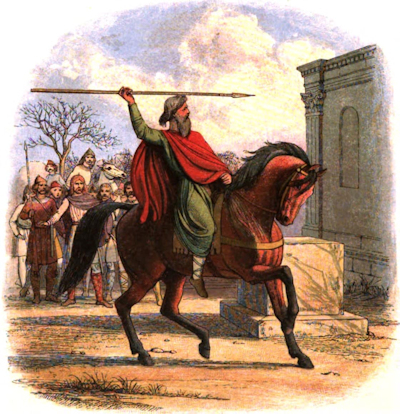 |
"The High Priest Coifi Profanes the Temple of the Idols", from James William Edmund Doyle's A Chronicle of England (1864). At Goodmanham.
|
Archbishop William of York (1140-1154), became canonised as a saint in 1227, which incidentally was the same time the fishponds were being stocked in the Palace site at Bishop Wilton, and the year most likely that the palace there was built. William Fitzherbert was born in about 1110, of a well-to-do family. Possessed of the right ‘connections’, he had by 1130 become Treasurer of York Minster and a chaplain to King Stephen. It is known the Treasurer of York had an interest in Bishop Wilton in 1208 and it is likely he used the Manor House near Bishop Wilton Church as a residence.
It can be found mentioned in the will of Martyn Colyns who was Treasurer from 1503 to 1509. Archbishop William Fitzherbert listed as one of his miracles the healing of a blind woman at Bishop Wilton. Nearby, in a Belthorpe copse, was the legendary well of St. Leonard. It is not known if St. Leonard’s Well was the magical healing source used by the Archbishop, but legend and stories have it that its water had healing properties for whoever drank it.
From a description by Edna Whelan it is: “situated about ½ mile from High Belthorpe Farm which is built on the moated site of an ancient farmstead. Here there were some years ago plainly visible two springs both flowing from grit stone and having each formed a basin in the stone. The larger was irregularly elliptical and about 30 inches wide, 18 inches broad and 24 inches deep, the smaller almost circular, with both its diameter and depth being 18 inches. The springs have now formed a pond with willows growing near. The waters were formerly noted for their healing powers, and are still thought to be beneficial. Many used the waters in the late 1800s, taking it away in bottles, and one Belthorpe farmer used to rise at five o’clock in the morning to drink of the water and left a cup nearby for anyone’s use. St Leonard was a hermit and monk of France in the 6th century and the patron saint of prisoners.”
St. Leonard was renowned for miracles of healing the sick and the name of St. Leonard’s given to the well was probably due to the healing properties of the water. Belthorpe is the site of an ancient house which, as can be seen from the map, has a moat and is likely to be the site of a Roman Villa or manor house. On the early maps an ancient track way down to the well may speculate it was possibly used as a small temple for pagan ritual.
Ley Lines and St Leonard’s Well
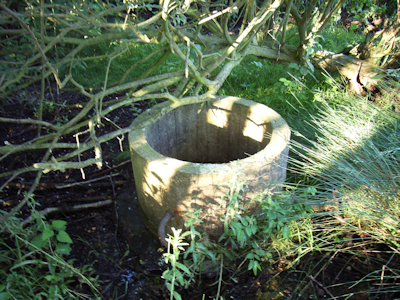 |
The ancient St. Leonard’s Well at High Belthorpe, said to have healing properties
|
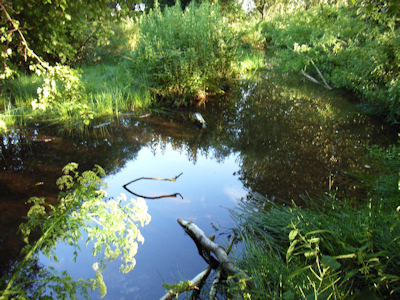 |
The spring near the well of St. Leonards
|
Ley Lines, or Leys, are alignments of ancient sites stretching across the landscape. Ancient sites or holy places may be situated in a straight line ranging from one or two to several miles in length. A Ley may be identified simply by an aligned placing of marker sites, or it might be visible on the ground for all or part of its length by the remnants of an old straight track.
Ley Lines were ‘re-discovered’ on 30 June 1921 by Alfred Watkins (1855-1935), a locally well-known and respected Herefordshire businessman, antiquarian and archaeologist, who while looking at a map for features of interest noticed a straight line that passed over hill tops through various points of interest, all of which were ancient. At the time of his discovery, Watkins had no theory about alignments but on that June afternoon saw ‘in a flash’ a whole pattern of lines stretching across the landscape.
Watkins surmised that these straight tracks, or Ley Lines as he called them at first, were the remnants of prehistoric trading routes. He went on to associate Ley Lines with the Greek god Hermes (the Roman Mercury, the Norse Woden) who was the god of communication and of boundaries, the winged messenger, and the guide to travellers on unknown paths. Watkins identified Hermes-Mercury with the chief god of the Druids and argued that:
“A Celtic god, Tout, or in its Romanised form Toutates, is supposed to be what Caesar referred to, and this name has been found on a Romano-British altar. It is a fact that sighting mounds called Tot, Toot, Tout, Tute and Twt abound all over the Kingdom, and the root is probably Celtic... The fact that such mounds are mark-points on track ways strengthens the link...”.
Remember the word ‘Tute’ as it crops up later.
The identification of Leys as ancient traders’ routes was as far as Watkins was prepared to go, despite the fact that numerous Ley Lines travelled up prohibitively steep hillsides. Speculation as to their meaning and purpose continued after Watkins’ death in 1935. An interesting Ley Line has been identified passing through St. Leonard’s Well.
A pagan king converts to Christianity
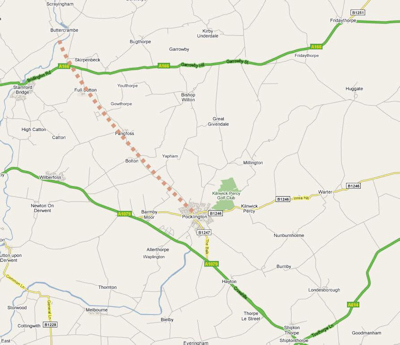 |
Tute Hill to Buttercrambe the palace of King Edwin of Northumbria
|
In the year 625 A.D., King Edwin of Northumbria, a widower with two sons, sought to strengthen his throne by asking for the hand of Ethelburga, the sister of Eadbald, the powerful king of Kent. Ethelburga was the daughter of Ethelbert, the king who reigned over Kent when St. Augustine came as a missionary to our shores in 597, and of his Christian wife Bertha. Eadbald yielded to Edwin’s request on the condition that his sister and her attendants should have full liberty to practise the Christian faith and that Edwin himself would take into careful consideration the advisability of himself becoming a Christian. So in the late summer of 625 Ethelburga with her maidens came north, and was married to our king.
A bishop of Roman origin named Paulinus had been consecrated at Rochester on July 21st of that year for the double purpose of ministering to the young queen and converting to the faith the wild heathen of Northumbria. Ethelburga must have been a most sweet and lovable person. Wherever she went, she was known as Tata, the Anglo-Saxon word for ‘darling’. In her later days she founded a convent at Lyminge in Kent, and some fields near are still known as ‘Tata’s Leas’. Edwin was a typical Anglo-Saxon, slow and thorough, cautious and of down-right honesty. Bede, who recorded the incidents of this period within two generations of their occurrence in his Ecclesiastical History, tells us that Edwin was “a man of extraordinary sagacity’’ and that “he often sat alone a long time, silent as to his tongue, but deliberating in his heart how he should proceed and to which religion he should adhere”. Interestingly, the church at Givendale is dedicated to Ethelburga.
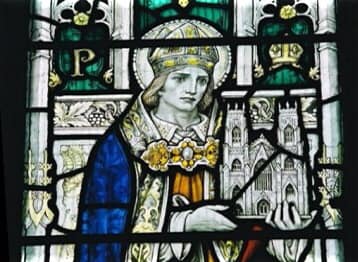 The ‘royal vill near the river Derwent’ which may still be seen as a dark mound in the gardens of Aldby Park on an eminence rising abruptly from the river, was the scene of a thrilling incident on the eve of Easter, April 19th, 626. The King, who was sojourning at the royal vill of Aldby, narrowly escaped assassination at the hand of an envoy of Cwichelm, King of the West Saxons, and on the same night Ethelburga gave birth to her first child, Eanfled, afterwards the wife of King Oswy. Paulinus was not slow to turn the incident to spiritual account, and Edwin readily consented to the baptism of Eanfled. On the following Whit Sunday, she and eleven others of the household were baptized, the first fruits of the Northumbrian race. After returning from a punitive expedition in which he was entirely victorious over the King of Wessex, Edwin called together a council of his nobles, and it was decided to adopt the Christian faith. (Left: Paulinus depicted holding York Minster) The ‘royal vill near the river Derwent’ which may still be seen as a dark mound in the gardens of Aldby Park on an eminence rising abruptly from the river, was the scene of a thrilling incident on the eve of Easter, April 19th, 626. The King, who was sojourning at the royal vill of Aldby, narrowly escaped assassination at the hand of an envoy of Cwichelm, King of the West Saxons, and on the same night Ethelburga gave birth to her first child, Eanfled, afterwards the wife of King Oswy. Paulinus was not slow to turn the incident to spiritual account, and Edwin readily consented to the baptism of Eanfled. On the following Whit Sunday, she and eleven others of the household were baptized, the first fruits of the Northumbrian race. After returning from a punitive expedition in which he was entirely victorious over the King of Wessex, Edwin called together a council of his nobles, and it was decided to adopt the Christian faith. (Left: Paulinus depicted holding York Minster)
Dr. Wilson was convinced that Pocklington was the site of the assembly which decided the conversion of King Edwin's realm to Christianity in the Northern Kingdom in 627. Bede mentions the place as a 'Royal Vill' nearby to Goodmanham. This meeting was not far from the great Druid shrine at Godmundingham (now Goodmanham) and is described in full and beautiful detail by Bede in his Ecclesiastical History. Discovered buried in Pocklington churchyard (probably hidden during the civil war), was the ancient Sotheby Cross. On it is a Latin inscription, "Pray for the soul of John Soteby." An inscription also in Latin at the foot of the cross. " Hic Pavlinus Celebravt et Predicavit A.D. 627." translated "Here Paulinus celebrated (the Holy Communion) and preached A.D. 627."
It is fascinating to me that all of Edwin’s manor houses at Bossal, Buttercrambe and Londesborough lie on the direct Ley Line with Goodmanham, one of the earliest Christian sites in Yorkshire. Following the conversion of Edwin to Christianity, he founded in 627 the great Cathedral Church at York and the Christian Church at Goodmanham on the site of the Pagan temple.
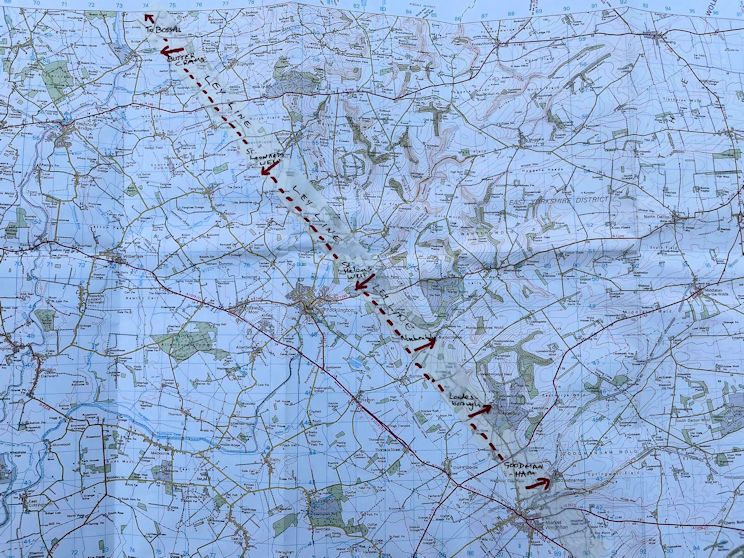
The speculative Ley Line running from Goodmanham to Buttercrambe/ Bossall
where King Edwin’s residences were including Londesborough
St. Helen’s well, Pocklington
Also on this Ley Line is St. Helen’s Well at Chapel Hill Pocklington, another ancient site of very early importance with possible pagan ritual connections. Later it is thought a chapel was built on the site but it had disappeared by the 19th century. Archbishop Ullathorne (born in Pocklington) records in his book an old tradition on Easter Sunday afternoon when the townsfolk would meet and “there in the old ruins of the old chapel and at the clear spring sat half of Pocklington, the children with sweets in their bottles and the grown people with wine and spirits in theirs tempering them with water from the spring, picking violets and primroses, and enjoying themselves with great freedom”. Pocklington has its share of pagan symbols around the church, with 21 heads depicting green-men, gods and goddesses, pomegranates, flowers and boughs. It also had the last witch-burning in England when in 1630 the Parish Register records “Old wife Green burnt in market for a witch”.
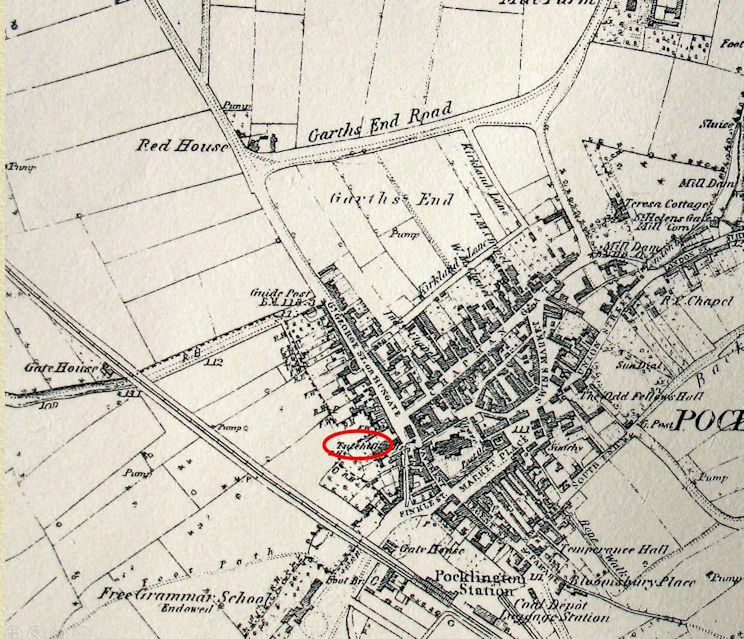
Tute Hill marked on the 1851 OS map
Tute Hill to Buttercrambe
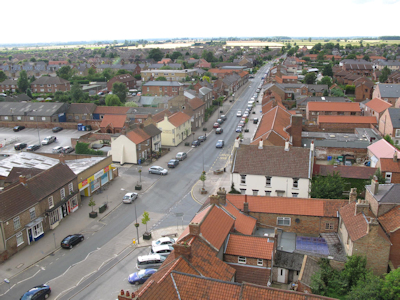 |
George street (old name Hungate) in 2007 from the tower of all saints. The impressive route in to Pocklington to Tute Hill, looks outwards to Buttercrambe.
|
As you look from the top of Pocklington All Saints down George Street, you would think that this impressive wide street would align with York. But it heads north towards Stamford Bridge. Is this to cross the Derwent there or is this alignment to something else? At the head of George Street at one side is the raised mound of Tute Hill, which by local stories could be the place of a castle or iron age fortress, or simply a lookout tower. The name Tute Hill derives from Old English tot, hyll - ‘look out hill’. All Saints church is on a raised mound on the other side of George St. opposite to Tute hill. So the two mounds could be ancient burial sites or very early fortifications.
George Street (old name Hungate) actually aligns in a direct line to Buttercrambe, the ancient home of King Edwin of Northumbria, the pagan king that converted to Christianity by destroying the pagan temple at Goodmanham. In AD627 Edwin’s high priest Coifi rode on horseback to Goodmanham and threw an axe at the door of the temple. He then set about smashing the altar and idols, demolished the temple and burnt it to the ground. King Edwin went on to be baptised in York at a place which is now the site of York Minster. St Leonard’s Well is also on this ancient alignment, which also happens to be parallel with the ancient Roman Road, which ran towards Stamford Bridge from Market Weighton. The Well is no doubt of very ancient origin as is the site at High Belthorpe, which may one day reveal its mysterious secrets.
Andrew Sefton 1st April 2021
|

